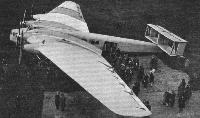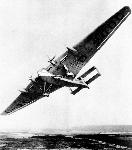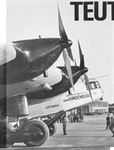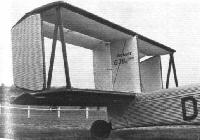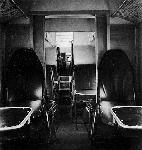
Варианты
- Junkers - G 38 - 1929 - Германия
- Mitsubishi - Ki.20 - 1931 - Япония
Junkers G.38
Junkers G.38 был очень амбициозным проектом фирмы - на момент своего первого полета он был самым большим сухопутным самолетом в мире. По конструкции и аэродинамике это была, в общем-то, типичная машина компании "Junkers", но с увеличенным крылом очень толстого профиля. Ее первый полет состоялся в 1929 году, а в 1931 году самолет, получив роскошную отделку, начал службу в авиакомпании "Luft Hansa".
<...>
ТАКТИКО-ТЕХНИЧЕСКИЕ ХАРАКТЕРИСТИКИ
Junkers G.38ce
Тип: четырехдвигательный пассажирский самолет
Силовая установка: четыре 12-цилиндровых V-образных двигателя Junkers L 88а мощностью по 750 л. с. (559 кВт), вращающих четырехлопастные деревянные винты диаметром 4,50 м
Летные характеристики: максимальная скорость 210 км/ч; крейсерская скорость 185 км/ч; потолок 3100 м; начальная скороподъемность 177 м/мин; время набора высоты 3000 м - 34 мин; продолжительность полета на крейсерской скорости 10 ч; разбег 400 м; пробег 260 м; посадочная скорость 93 км/ч
Масса: пустого 16 400 кг; максимальная взлетная 23 000 кг; запас топлива 2610 кг
Размеры: размах крыла 44 м; длина 23,2 м; высота 7,20 м; площадь крыла 305 м2
Экипаж и полезная нагрузка: семь человек (два пилота, капитан, радист, два бортмеханика, стюард); 32-34 пассажира
Описание:
- Junkers G.38
- Flight, February 1929
A NEW JUNKERS COMMERCIAL MONOPLANE - Flight, November 1929
THE JUNKERS G. 38.
Фотографии
-
Мировая Авиация 126
Регистрационный номер: D-APIS [6] G 38ce. Второй G 38 имел долгую историю эксплуатации, трижды сменив за ее время свое обозначение. Впервые взлетев в 1932 году, в июне он получил сертификат, а в июле начал службу в авиакомпании "Lufthansa". Машина с регистрационным номером D-2500 работала на линиях, связывающих Берлин со Скандинавскими странами, Веной и Римом, Амстердамом и Лондоном, Данцигом и Кенигсбергом, а также маршрутах внутри Германии. В 1934 году самолет получил новый регистрационный номер D-APIS и продолжал службу в "Lufthansa" до 1939 года. Мобилизованный в сентябре Люфтваффе, он служил в подразделении KGrbV 172 под регистрационным номером GF-GG.
-
Мировая Авиация 162
Один Junkers G.38b был мобилизован для службы в Люфтваффе в сентябре 1939 и использовался для перевозок на Балканах. Олицетворявший концепцию "Grossflugzeug" (тяжелый и крупногабаритный), этот самолет имел крыло с толстым профилем, в котором размещались дополнительные места для пассажиров. Самолет также строился в Японии как тяжелый бомбардировщик Mitsubishi Ki-20. Всего построили восемь самолетов.
-
Aeroplane Monthly 1987-12 / J.Stroud - Wings of Peace
The first G 38 in its original form, with large undercarriage spats.
-
Aeroplane Monthly 1997-06 / H.Amtmann - My Junkers years
The first G 38 runs-up its engines. The retractable underwing oil and water radiators are well shown. The large undercarriage spats were not retained.
-
Flight 1929-11 / Flight
THE AGE OF THE LARGE AIRCRAFT: The Junkers G.38 has now been completed and has made its first test flights. The machine is a step towards Dr. Junkers' ideal of the "flying wing." The machine is fitted with 4 Junkers I.55 engines, partly housed in the wing, and has a span of 147-5 ft.
-
Aeroplane Monthly 1987-12 / J.Stroud - Wings of Peace
Регистрационный номер: D-2000 [17] Early view of the G 38 after removal of the spats.
-
Мировая Авиация 126
Регистрационный номер: D-2000 [17] Этот снимок позволяет оценить огромные размеры крыла первого G 38 в первоначальном варианте. Проходы в крыле обеспечивали доступ к двигателям в полете. Демонтаж двигателей мог быть произведен через люки в верхней поверхности крыла.
-
Aeroplane Monthly 1997-06 / H.Amtmann - My Junkers years
The unmarked G 38 prototype, showing the original single-deck fuselage configuration. A Junkers-A 50 Junior all-metal two-seater is in the foreground.
Другие самолёты на фотографии: Junkers A 50 Junior - Германия - 1929
-
Авиация и Космонавтика 2010-01 / Ю.Кузьмин - Алюминий в авиации. Кто же первый? /Мифы в истории авиации/
Регистрационный номер: D-2000 [17] Юнкерс G.38
-
Flight 1931-06 / Flight
Регистрационный номер: D-2000 [17] THE BUSINESS END OF D.2000: The two inner engines of the Junkers G.38 are Junkers L.88 of 800 h.p. each, while the two other engines are Junkers L.8, of 350 h.p. each.
-
Aeroplane Monthly 1997-06 / H.Amtmann - My Junkers years
Регистрационный номер: D-2000 [17] A close-up of the first G 38, showing the starboard inboard Junkers L 88 with its four-bladed propeller, the undercarriage and the glazing in the wing root.
-
Flight 1929-11 / Flight
Регистрационный номер: D-2000 [17] -
Flight 1931-07 / Flight
WELL AWAY: A good picture of the giant Junkers "G.38" commercial monoplane taking off during its recent tour of Europe.
-
Aeroplane Monthly 1987-12 / J.Stroud - Wings of Peace
Регистрационный номер: D-AZUR The first G 38 after it was named Deutschland and re-registered D-AZUR
-
Flight 1929-11 / Flight
Регистрационный номер: D-2000 [17] -
Jane's All the World Aircraft 1980 / Encyclopedia of Aviation - Aircraft A-Z - v4
Регистрационный номер: D-2000 [17] Junkers G 38.
-
Aeroplane Monthly 1987-12 / J.Stroud - Wings of Peace
Регистрационный номер: D-2000 [17] The Junkers G.38 D-2000 (4 Junkers engines) making an approach to Croydon on June 12, 1931.
-
Aeroplane Monthly 1973-07 / ??? - Teutonic Titan
Регистрационный номер: D-2000 [17] Only two Junkers G-38s were built in Germany, the example on photo, D-2000, later D-AZUR Deutschland, being the first. There was room for 34 passengers on two levels.
-
Flight 1929-11 / Flight
Регистрационный номер: D-2000 [17] -
Aeroplane Monthly 1987-12 / J.Stroud - Wings of Peace
Регистрационный номер: D-2000 [17] Junkers-G 38 D-2000 shows off its massive bat-like wing. Note the leading-edge cabin windows.
-
Мировая Авиация 162
Регистрационный номер: D-2000 [17] Первый прототип гигантского Junkers G.38 в полете над Германией в ходе испытаний демонстрирует свое огромное крыло. Обратите внимание на решетки радиаторов под крылом.
-
Aeroplane Monthly 1993-04 / C.Prower - From Brisfit to Beverley (1)
Регистрационный номер: D-2000 [17] Underside plan view of Junkers-G 38 D-2000 passing over Croydon in September 1931. It had been delivered to Deutsche Luft Hansa in June the previous year.
-
Aeroplane Monthly 1987-12 / J.Stroud - Wings of Peace
Регистрационный номер: D-2000 [17] The first G 38, D-2000, over Croydon Airport.
-
Flight 1932-07 / Flight
Регистрационный номер: D-2500 [9] A NEW VERSION OF THE JUNKERS G.38: The "D 2500" which has just been put into service on the Berlin-London route by Luft Hansa. It has accommodation for 34 persons.
-
Aeroplane Monthly 1987-12 / J.Stroud - Wings of Peace
Регистрационный номер: D-2500 [9] D-2500 as the G 38ce at Tempelhof, Berlin.
-
Aeroplane Monthly 1987-12 / J.Stroud - Wings of Peace
Регистрационный номер: D-APIS [6] Rhe same aircraft, re-registered D-APIS and with modified cabin windows.
-
Aeroplane Monthly 1998-10 / A.Welch - A Different World (2)
Регистрационный номер: D-2500 [9] Luft Hansa’s massive Junkers-G 38 first flew in to Croydon on July 1,1931. This is the second aircraft, D-2500. The author saw one low over her house in company with the airship Graf Zeppelin.
-
Авиация и Космонавтика 2024-11 / Некоторые знаменательные даты ноября в истории авиации
Регистрационный номер: D-2500 [9] -
Мировая Авиация 126
Регистрационный номер: D-2500 [9] На момент своего первого полета в ноябре 1929 года G 38 был самым большим сухопутным самолетом в мире. Второй самолет (на снимке) уже не имел гигантских обтекателей колес, как у первой машины.
-
Aeroplane Monthly 1997-06 / H.Amtmann - My Junkers years
Регистрационный номер: D-2500 [9] THE ESCORT: The Junkers G.38, with more powerful engines and a "storey" added to her fuselage, accompanied the "Graf Zeppelin."
This study of the second Junkers-G 38, D-2500, emphasises the type’s massive wide-chord wing, which incorporated “observation rooms" from which passengers could admire the passing scenery. -
Aeroplane Monthly 1997-06 / H.Amtmann - My Junkers years
Регистрационный номер: D-2500 [9] THREE BIG THINGS IN AVIATION: This photo - for which we have to thank our friends Shell-Mex Sc B.P.,Ltd. - taken recently over the Ausseralster, the larger of the two lakes in the centre of Hamburg, shows the Junkers G.38, the world's largest landplane, in flight; the Dornier Do. X, the world's largest flying-boat, moored on the left; and the new extensive Shell Haus on the lakeside on the right.
Другие самолёты на фотографии: Dornier Do.X - Германия - 1929
-
Flight 1936-05 / Flight
BROMMA IN ACTION: Transport machines of three nations at Stockholm's airport. On the ground are a British Continental Airways' D.H.86A and a Breguet-Wibault of Air France, while in the air is the Von Hindenburg, one of D.L.H.'s two Junkers G.38s, which have Jumo diesel engines.
Другие самолёты на фотографии: De Havilland Express Air Liner / D.H.86 - Великобритания - 1934Wibault Wibault 280 - Франция - 1930
-
Flight 1936-08 / Flight
Регистрационный номер: D-APIS [6] DIESEL GIANT: The Junkers G.38, with four Jumo IV diesel engines, gets her tail up for a tarmac take-off at Croydon.
-
Flight 1938-07 / Flight
An early application of the Diesel to commercial aircraft was in the vast Junkers G.38, which had four of the 600/750 h.p. Jumo 204 type units.
The machine originally had petrol engines but has now been fitted with four Junkers diesels. The neat cowling of these large engines is shown in the picture. -
Aeroplane Monthly 1979-10 / Croydon /Gone but not forgotten/ (5)
Регистрационный номер: D-APIS [6] The awesome Junkers-G 38 D-APIS at Croydon in August 1936. D-APIS was originally registered D-2500 and named General-feldmarschall von Hindenburg. It was destroyed at Athens during the war by RAF bombing.
-
Aeroplane Monthly 1987-12 / J.Stroud - Wings of Peace
Регистрационный номер: D-APIS [6] G 38 D-APIS at Croydon, with the wing cabin windows clearly visible.
-
Flight 1936-08 / Flight
An interesting visitor to Croydon early this week was the huge Junkers G.38, shown in front view.
-
Flight 1933-08 / Flight
Регистрационный номер: D-2500 [9] "GENERALFELDMARSCHALL VON HINDENBURG": The Junkers G 38 D2500 which, as previously reported in FLIGHT, was christened at Tempelhof Aerodrome, Berlin, by the Field Marshal.
-
Мировая Авиация 126
Второй G 38 незадолго до мобилизации в Люфтваффе. К этому времени самолет уже имел силовую установку из четырех двигателей L 88а, вращавших четырехлопастные винты.
Junkers G 38 Generalfeldmarschall von Hindenburg. -
Мировая Авиация 126
На этом снимке G 38ce хорошо видны решетки радиаторов, кабина в корневой части крыла и носовые прожекторы. Перед возвращением в "Lufthansa" в 1932 году G 38 получили имена "Deutschland" и "Generalfeldmarschall von Hindenburg" (на снимке) нанесенные на носовую часть.
-
Авиация и Космонавтика 2014-11 / Знаменательные даты ноября в истории авиации
Регистрационный номер: D-2500 [9] Самый большой самолет фирмы Хуго Юнкерса - G 38
-
Aeroplane Monthly 1980-01 / Luftwaffe in Camera
This Junkers G-38 transport was operated by KGr zbV 172 and was later destroyed on the ground during an RAF attack on Athens/Tatoi aerodrome on May 17, 1941.
-
Flight 1934-09 / Flight
REPLACEMENT: Hoisting one of the "Jumo 4" Diesel engines into the Junkers G.38 Von Hindenberg. This is, incidentally, one of the two types being manufactured under licence by D. Napier and Son, Ltd., and it will be known here as the "Culverin."
-
Aeroplane Monthly 1987-12 / J.Stroud - Wings of Peace
The second G 38 under construction at Dessau.
A TWO-STOREY AIRBUS: The large Junkers G.38 airliner has been modified to meet the demand for extra passenger space by the addition of a "second storey" on top of the fuselage, between the wings. A smoking compartment has also been provided. The machine will be put into service between Berlin and London.
-
Aeroplane Monthly 1997-06 / H.Amtmann - My Junkers years
Professor Hugo Junkers in front of the G 38. He died in February 1935, on his 76th birthday.
-
Flight 1931-06 / Flight
NOT DECORATIVE: The biplane tail of the Junkers G.38 does not add to the beauty of the machine, but a large-span monoplane tail behind four engines would probably have had an unhappy time of it.
-
Flight 1929-02 / Flight
Taking Shape: The wing for the J.38 being assembled at the Junkers Dessau works.
-
Мировая Авиация 126
Пассажиры G 38 пользовались большим комфортом, чем на других авиалайнерах. На снимке представлен вид в хвостовую часть нижней кабины. Позади небольшой лестницы расположен курительный салон. В нижней и верхней пассажирских кабинах размещалось по 11 человек.
-
Aeroplane Monthly 1987-12 / J.Stroud - Wings of Peace
View from the smoking cabin through the main lower deck cabin to the upper deck of one of the G 38s.
-
Flight 1929-02 / Flight
Регистрационный номер: D-2000 [17] THE NEW JUNKERS MONOPLANE: This photograph shows two scale models, the J.38 on the right and the W.33 on the left for purposes of comparison.
Другие самолёты на фотографии: Junkers F 13 - Германия - 1919
-
Aeroplane Monthly 1987-12 / J.Stroud - Wings of Peace
Регистрационный номер: D-APIS [6] KEITH WOODCOCK'S painting shows the Lufthansa G 38 Generalfeldmarschall von Hindenburg approaching Croydon Airport.
-
Aeroplane Monthly 1986-12
Having painted the main American bombers in earlier pictures, I thought I might extend the “nose art” theme to other subjects. For Deutsche Lufthansa the most famous and beautiful of all Germans was chosen. The plan was to show her as “Lola” - or is it “Lili Marlene”? - painted on the nose of the giant Junkers-G 38. However, I decided that the picture was too delicately balanced in tone to take two figures, so I abandoned the original concept ana somehow a Ju 52 drifted into the scene... PHILIP CASTLE
Другие самолёты на фотографии: Junkers Ju.52/3m - Германия - 1931
-
Aeroplane Monthly 1989-11
Регистрационный номер: D-2000 [17] First flight of Junkers-G 38: November 6, 1929
-
Flight 1937-05 / Flight
Four German types in regular service fitted with Junkers Jumo compression-ignition engines.
Другие самолёты на фотографии: Dornier Do.18 - Германия - 1935Junkers Ju.52/3m - Германия - 1931Junkers Ju.86 - Германия - 1934
- Фотографии




